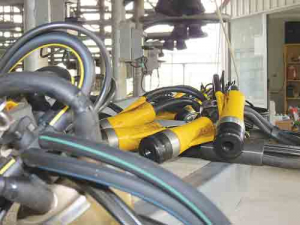The teat cup liner is the only part of a milking machine that contacts a cow’s teat.
It has a large influence on milking performance, udder and teat health.
Selecting the right liner and maintenance of teat cup have several benefits: improved animal health, where teats are not damaged leading to issues with mastitis; increased milking efficiency -- the right liners will help the clusters to stay on; cows are not slow to milk; and reduced stress on animals.
Ensure the liners are not causing pain, which will lead to cow discomfort and animal handling issues.
A good teat cup liner will:
- Provide an airtight seal at both ends of the shell
- Provide a mouthpiece and barrel of a size that will fit a range of teat shapes and sizes, minimising liner slips and cluster falls and damage that can lead to mastitis
- Milk out quickly and completely, minimising teat congestion, discomfort, and injury
- Be easily cleaned.
- The choice of a liner is a compromise -- considering the milking machine, its settings and, importantly, the cows.
Ultimately, if the proposed liner fits the milking equipment it can be compared in the milking performance of your cows alongside other liners aiming for fast, efficient milking without any ill effects. Even then a better performing liner may warrant some change in equipment.
The performance of cup liners is heavily influenced by the design and management of the whole dairy. Liner slip, in particular, is often not due to a problem with the liner itself. To optimise the milking process, milking machinery should be assessed in its entirety. Liners need to be carefully selected to suit the herd and machinery, and changed regularly.
Liners are commonly classified by their barrel size and shape and by the material and/or method of their manufacture.
Liners in wide array
Liners are commonly described as wide, medium or narrow-bore depending on their internal diameter relative to the average teat size for a given herd.
A wide-bore liner is at least 1mm larger than the mean teat diameter measured at the mid-point of the teats. A narrow-bore liner is at least 2mm smaller than the mean mid-teat diameter of the herd. Talk to experienced suppliers and technicians to help decide on a size that suits your operation.
Most New Zealand liners have a cylindrical barrel, but square, triangular and oval designs are now also on the market.
Good cleaning systems
A good cleaning system with regular hot alkaline washes is necessary to maintain liner performance. Poor cleaning can result in faster surface deterioration and bacteria growth.
Liners should be removed from jetter wash systems after cleaning. Leaving liners on any type of jetter between milkings will not allow the system to dry and can increase bacteria growth. Liners left hanging on button style jetters can distort the mouth-piece, increasing slip and reducing liner life.
Liners should not be re-tensioned by pulling them up to a second tension ring after half of their life; they should be replaced as they are worn out. Re-tensioning will only improve milking for a short time. Over-tensioned liners may lead to teat end damage.
• Article source: DairyNZ


















